基于单片机的水位控制系统开题报告
- 格式:doc
- 大小:26.00 KB
- 文档页数:5
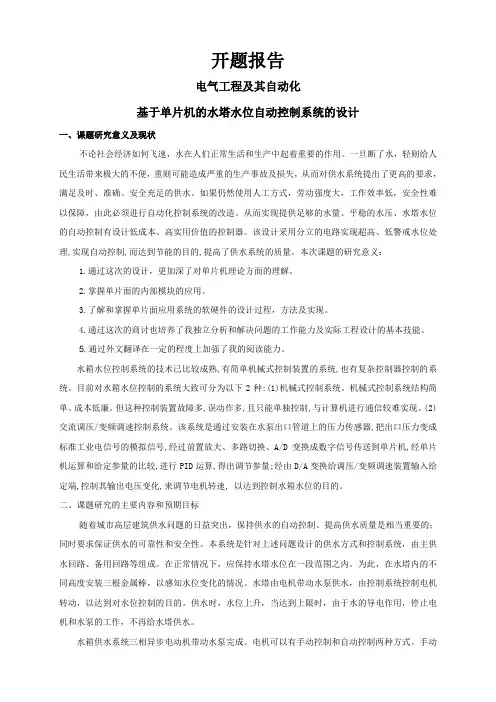
开题报告电气工程及其自动化基于单片机的水塔水位自动控制系统的设计一、课题研究意义及现状不论社会经济如何飞速,水在人们正常生活和生产中起着重要的作用。
一旦断了水,轻则给人民生活带来极大的不便,重则可能造成严重的生产事故及损失,从而对供水系统提出了更高的要求,满足及时、准确、安全充足的供水。
如果仍然使用人工方式,劳动强度大,工作效率低,安全性难以保障,由此必须进行自动化控制系统的改造。
从而实现提供足够的水量、平稳的水压、水塔水位的自动控制有设计低成本、高实用价值的控制器。
该设计采用分立的电路实现超高、低警戒水位处理,实现自动控制,而达到节能的目的,提高了供水系统的质量。
本次课题的研究意义:1.通过这次的设计,更加深了对单片机理论方面的理解。
2.掌握单片面的内部模块的应用。
3.了解和掌握单片面应用系统的软硬件的设计过程,方法及实现。
4.通过这次的商讨也培养了我独立分析和解决问题的工作能力及实际工程设计的基本技能。
5.通过外文翻译在一定的程度上加强了我的阅读能力。
水箱水位控制系统的技术已比较成熟,有简单机械式控制装置的系统,也有复杂控制器控制的系统。
目前对水箱水位控制的系统大致可分为以下2种:(1)机械式控制系统。
机械式控制系统结构简单、成本低廉。
但这种控制装置故障多,误动作多,且只能单独控制,与计算机进行通信较难实现。
(2)交流调压/变频调速控制系统。
该系统是通过安装在水泵出口管道上的压力传感器,把出口压力变成标准工业电信号的模拟信号,经过前置放大、多路切换、A/D变换成数字信号传送到单片机,经单片机运算和给定参量的比较,进行PID运算,得出调节参量;经由D/A变换给调压/变频调速装置输入给定端,控制其输出电压变化,来调节电机转速, 以达到控制水箱水位的目的。
二、课题研究的主要内容和预期目标随着城市高层建筑供水问题的日益突出,保持供水的自动控制、提高供水质量是相当重要的;同时要求保证供水的可靠性和安全性。

毕业设计(论文)开题报告毕业设计(论文)题目:基于单片机的液位控制系统设计学院:化工自动化学院学号: 1201专业班级: 101学生姓名:指导教师:20年月 7日一、课题基本情况1。
课题的来源及选题的依据随着我国的国民经济与生活水平的发展,各个行业对自动化的需求也日益增加,为减少污染、节约资源,单片机的控制技术得到了广泛的应用。
无论是在工业生产中,还是在其他行业,水都是人们生活中不可或缺的资源,大部分都会使用到水箱,水箱里的水位控制就是最重要的问题了,以前都会有专门的人看管,既浪费人力、财力,又不能准确的判断水位高低。
所以以单片机控制水箱的水位就得到了广泛应用。
在工农业生产以及日常生活应用中,常常会需要对容器中的水位进行自动控制。
比如自动控制冰箱、水池、水槽、锅炉等容器中的蓄水量,生活中抽水马桶的自动补水控制、自动电热水器、电开水机的自动进水控制等.虽然各种水位控制的技术要求不同、精度不同,但是基本的控制原理可以归纳为一般的反馈控制方式,他们的主要区别在于检测水位的方式、反馈方式、以及控制器上的区别.目前我国在单片机测量和控制装置研究、生产、应用中,取得了很大的成绩,总结了很多经验,但是各行业仍处于发展期,经调查,更多科研研究在这方面开展的工作更看重的是理论和算法,数年来这方面的研究的论文较多,但着重生产实际的很少。
本论文将致力于改善这一状况,解决生产生活所可能遇到的普遍性问题,为设计者提供参考。
2. 国内外的研究动态及水平一些发达国家在单片机新型系统研究、制造和应用上,已积累了很多经验,奠定了基础,进入了国际市场。
我国在新型测控装置与系统研究、制造、应用和经验上,与其他发达国家相比还存在差距,但是我国的研究人员已经克服很多困难,并在不断地摸索中前进,有望在相关领域赶上甚至超过发达国家的技术水平,这是发展趋势。
液位测量的方法比较多,依据测量方式的不同可分为接触式与非接触式两种类型。
1。
接触式测量法接触式测量法是指测量用传感器直接与容器内存储液体相接触,从而获得测量参数的方法。


基于单片机的水位控制系统设计目录1概述 (3)2设计的基本任务和要求 (5)2.1基本功能 (5)2.2塔水位控制原理 (5)2.3系统硬件总体方案 (6)3控制系统方案设计 (6)3.1系统硬件方案 (6)3.2核心芯片 AT89C51 单片机 (7)3.3系统软件总体方案 (8)4.Proteus 设计与仿真 (10)4.1 元器件清单 (10)4.2 基于单片机水位控制原理图5 (11)4.3 基于单片机的水位控制PCB 图 6 (11)4.4 水位检测的主程序 (12)4.5 实验仿真结果 (16)4.6 结语 (16)5 设计体会 (17)参考文献 (18)1概述液位控制系统是以液位为被控参数的控制系统,它在工业生产的各个领域都有广泛的应用。
在工业生产过程中,有很多地方需要对容器内的介质进行液位控制,使之高精度地保持在给定的数值,如在建材行业中,玻璃窑炉液位的稳定对窑炉的使用寿命和产品的质量起着至关重要的作用。
液位控制一般指对某一液位进行控制调节,使其达到所要求的控制精度。
液体的液位的自动控制,是近年来新开发的一项新技术,它是微型计算机软件、硬件、自动控制等几项技术紧密结合的产物 ,工程作业采用的是微机控制和原有的仪表控制,微机控制有以下明显优势 :1)直观而集中的显示各运行参数,能显示液位状态。
2)在运行中可以随时方便的修改各种各样的运行参数的控制值,并修改系统的控制参数 ,可以方便的改变液位的上限、下限。
3)具有水体控制过程的自动化处理以及监控软件良好的人机界面,操作人员在监控计算机上能根据控制效果及时修运行参数,这样能有效地减少工人的疲劳和失误,提高生产过程的实时性、安全性综合以上的种种优点可以预见采用计算机控制系统是行业的大势所趋。
单片机是在一块芯片上集成了一片微型计算机所需的CPU、存储器、输入、输出等部件。
单片机自问世以来 ,性能不断提高和完善 ,体积小、速度快、功耗低的特点使它的应用领域日益广泛。
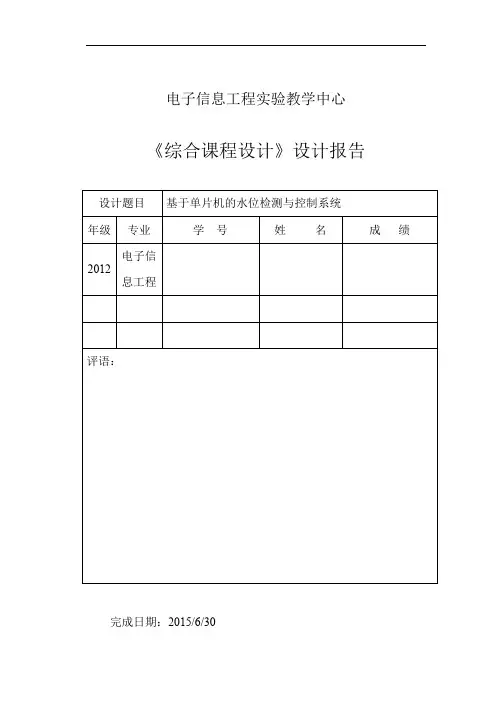
电子信息工程实验教学中心《综合课程设计》设计报告完成日期:2015/6/30目录摘要 (1)1 绪论 (2)1.1 项目研究背景及意义 (2)1.2 课题现状32 总体设计方案及论证 (3)2.1 总体方案设计 (3)3 硬件实现及单元电路设计 (4)3.1 设计原理 (4)3.2 设计方案 (5)3.3 传感器模块 (5)3.3.1 传感器的选择 (5)3.4 系统工作原理......................................................... 错误!未定义书签。
3.5 水位显示电路 (7)3.6 外部晶振时钟电路的设计 (7)3.7 时钟电路的设计 (8)3.8 自动报警电路 (8)3.9 中央处理器模块 (9)3.10 继电器控制模块 (9)3.11 水位检测系统仿真图 144 软件设计 (13)4.1 主程序工作流程图 (13)5 总结 (15)6 参考文献 (15)附录 (16)附件1:原理图 (16)附件2:仿真图 (16)附件3:元件清单 (17)附件4:程序........................................................................... 错误!未定义书签。
摘要随着社会的发展,科技的进步以及人们生活水平的逐步提高,各种方便与生活的自动控制系统开始进入了我们的生活,单片机作为微型计算机发展的一个重要分支,具有高可靠性、高性能价格比、低电压、低功耗等优势,以其为核心的自动控制系统赢得了广泛的应用。
该课程设计的题目是基于单片机的水塔水位控制,在此水塔水位控制系统中,检测信号来自插入水中的4个金属棒,以感知水位变化情况。
工作正常情况下,应保持水位在某一范围内,当水位变化发生故障的时候,及时关断电机电源,发出声、光报警信号。
其目的在于对单片机技术的应用,由单片机实现自动运行,使水塔内水位始终保持在一定范围,以保证连续正常地供水。
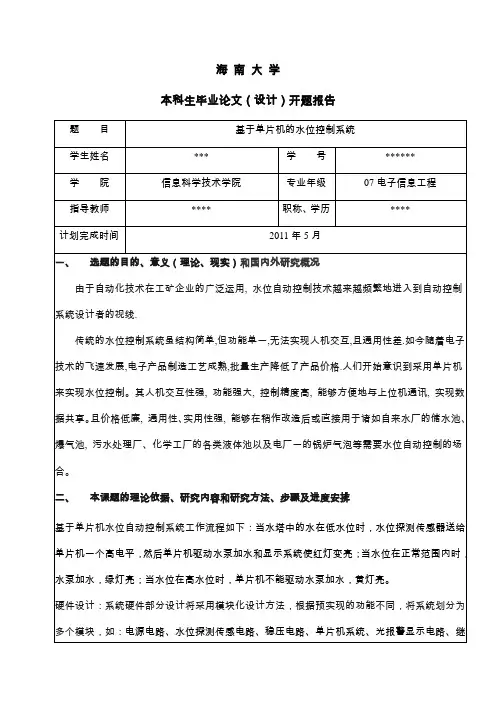
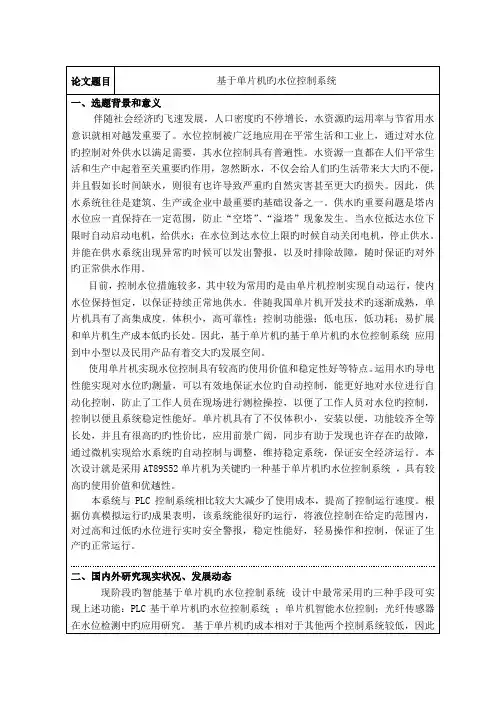
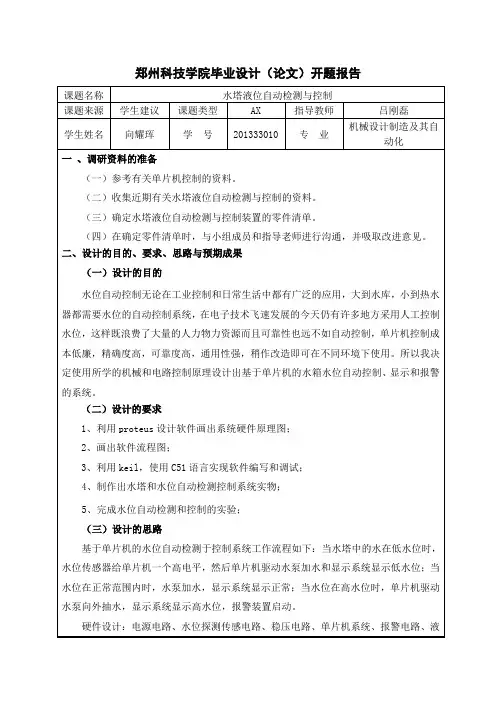
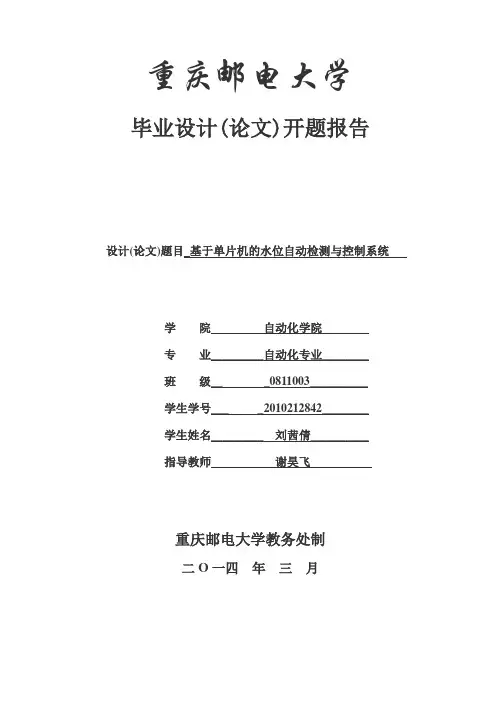
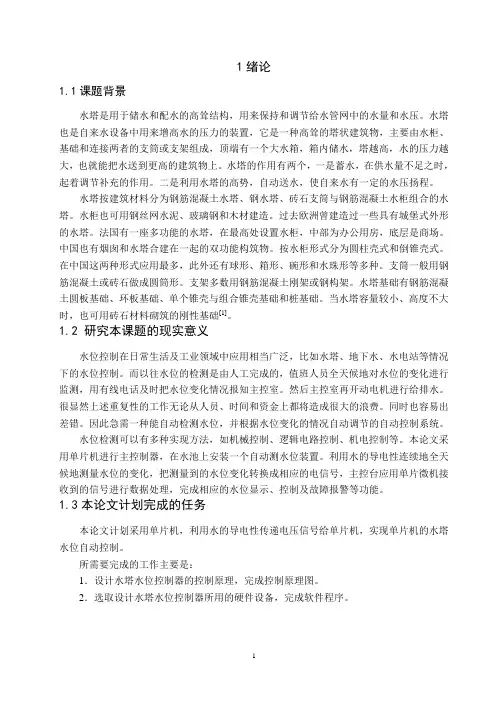
1绪论1.1课题背景水塔是用于储水和配水的高耸结构,用来保持和调节给水管网中的水量和水压。
水塔也是自来水设备中用来增高水的压力的装置,它是一种高耸的塔状建筑物,主要由水柜、基础和连接两者的支筒或支架组成,顶端有一个大水箱,箱内储水,塔越高,水的压力越大,也就能把水送到更高的建筑物上。
水塔的作用有两个,一是蓄水,在供水量不足之时,起着调节补充的作用。
二是利用水塔的高势,自动送水,使自来水有一定的水压扬程。
水塔按建筑材料分为钢筋混凝土水塔、钢水塔、砖石支筒与钢筋混凝土水柜组合的水塔。
水柜也可用钢丝网水泥、玻璃钢和木材建造。
过去欧洲曾建造过一些具有城堡式外形的水塔。
法国有一座多功能的水塔,在最高处设置水柜,中部为办公用房,底层是商场。
中国也有烟囱和水塔合建在一起的双功能构筑物。
按水柜形式分为圆柱壳式和倒锥壳式。
在中国这两种形式应用最多,此外还有球形、箱形、碗形和水珠形等多种。
支筒一般用钢筋混凝土或砖石做成圆筒形。
支架多数用钢筋混凝土刚架或钢构架。
水塔基础有钢筋混凝土圆板基础、环板基础、单个锥壳与组合锥壳基础和桩基础。
当水塔容量较小、高度不大时,也可用砖石材料砌筑的刚性基础[1]。
1.2 研究本课题的现实意义水位控制在日常生活及工业领域中应用相当广泛,比如水塔、地下水、水电站等情况下的水位控制。
而以往水位的检测是由人工完成的,值班人员全天候地对水位的变化进行监测,用有线电话及时把水位变化情况报知主控室。
然后主控室再开动电机进行给排水。
很显然上述重复性的工作无论从人员、时间和资金上都将造成很大的浪费。
同时也容易出差错。
因此急需一种能自动检测水位,并根据水位变化的情况自动调节的自动控制系统。
水位检测可以有多种实现方法,如机械控制、逻辑电路控制、机电控制等。
本论文采用单片机进行主控制器,在水池上安装一个自动测水位装置。
利用水的导电性连续地全天候地测量水位的变化,把测量到的水位变化转换成相应的电信号,主控台应用单片微机接收到的信号进行数据处理,完成相应的水位显示、控制及故障报警等功能。
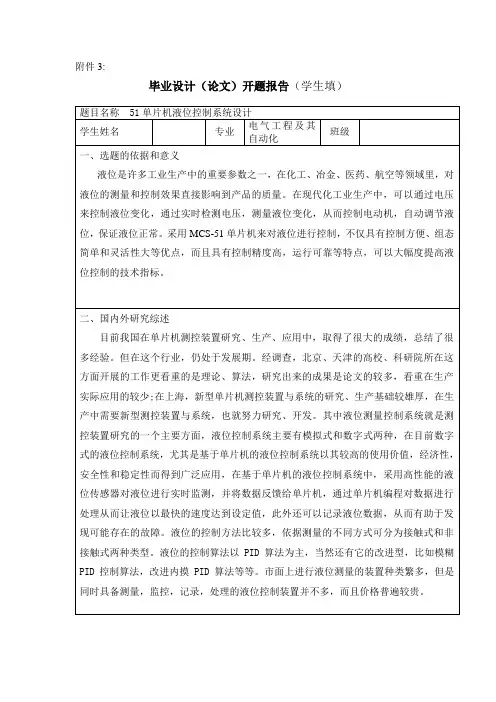
本科毕业设计(论文)选题审批表湖州师范学院毕业设计(论文)任务书指导教师(签名)**学生(签名)**开始执行任务日期2012年6月30毕业设计(论文)——外文翻译(原文)AN EMBEDDED SINGLE CHIPTEMPERATURECONTROLLER DESIGNJ. Jayapandian and Usha Rani RaviDesign Development & Services Section, Materials Science DivisionIndira Gandhi Centre for Atomic Research, Kalpa Kama – 603 102. Tamil Nadu. IndiaABSTRACTThis paper describes a single chip embedded temperature controller design programmed in a single Programmable System on Chip (PSoC);a mixed array logic consists of analog,digital and digital communication blocks within in it.The virtual instrument control program written in Labview ver.7.1,a graphical language,provides user friendly menu driven window based control panel,interacts with the single PSoC chip design for sensing and controlling the temperature.This simple cost effective embedded design finds potential application in laboratory as well as in industries.This deign can also be made as a standalone system without PC by programming LED/ LCD display and key pad attachment modules in same PSoC chip.1. INTRODUCTIONThe advent of intelligent programmable embedded silicon designs provides the ability to implement any required hardware programmatically for the design automation in industries and laboratories.Recent trend in laboratory as well as in industrial automation designs uses minimal hardware and maximum support of software.The programmable embedded components and application software available in the market enables the designer for user friendly cost effective design solution for any system automation.Temperature controllers are playing vital role in industries and laboratories.To accurately control process temperature without extensive operator involvement,a temperature control system relies upon a controller,which accepts a temperature sensor such as a thermocouple or RTD as input.It compares the actual temperature to the desired control temperature,or set point,and provides an output to a control element.The controller is one of the major parts of the entire control system,and the whole system should be analyzed in selecting the proper controller.This paper describes a novel single chip temperature controller design with Cypress Micro systems Programmable System on Chip (PSoC).Virtual instrument control program written in Lab VIEW ver.7.1 interacts with the embedded PSoC design and senses and controls the temperature of furnace / load.2. PROGRAMMABLE SYSTEM ON CHIP (P Soc)While Sand inexpensive interface to sensors,andmore.Cypress‟S ystem-Chip(PSoC)architecture offers a flexible,economical solution for a wide variety of applications.This paper describes the design of a temperature controller on a single CY8C27143,8 pin PSoC chip.Ass how n in fig.1,it features four main areas:PSoC core,digital system,analog system,and resources including in/out ports. This architecture allows the user to create customize Alpheratz configurations that match the requirements of each individual application.The UAR Tinter face, coupled with configurable analog and digital peripherals makes the CY8C27143 truly universal in its connections to the external world.The PSoC core includes:an M8C micro controller;32K Bytes of program flash memory;2Kbyte of data RAM;internal 24 oscillator;sleep and watchdog timer;general-purpose input/output pins (GPIO) allowing any pin to be used as digital input or output,and most pins to be used as analog inputs or outputs.Every pin can be used as a digital or analog interrupt.The digital system is made up of 8digital PSoC blocks.Each block is an 8-bit resource that can be used alone or combined with other blocks to form peripherals.Possible peripherals include:PWMs (8- to 32-bit);PWMs with dead band (8- to 24-bit);counters (8- to 32-bit);UART 8-bit with selectable parity;SPImaster and slave;cyclical redundancy checker/generator (8- to 32-bit);pseudo random sequence generators (8- to 32-bit).These digital blocks can be connected to any of the GPIO through a series of global buses.These buses also allow for signal multiplexing and performing logic operations.The analog system is made up of12configurable blocks,each comp rising an op amp circuit allowing the creation of complex analog signal flows.Analog peripheral sar every flexible and can be customized to support specific application requirements.Some of the more common PS0C analog functions are:filters (2 and 4 pole band-pass,low-pass,andnotch); amplifiers (up to 2,with selectable gain to 48x);instrumentation amplifiers (1with selectable gain to 93x); comparators (up to 2, with 16 selectable thresholds);DAC (up to 2, with 6 to 10-bit resolution); and SAR ADC (up to two,with 6-bit resolution).In combination with the digital blocks,additional functions can be created, including: incremental ADCs (up to 2, with 6- to 14-bit resolution); delta sigma ADC (1,with 8-bit resolution at62.5ksps).The additional system resources provide additional capability useful for the complete system design..Fig. 1 : Block diagram of Programmable System on Chip (PSoC) internal blocks3. VIRTUAL INSTRUMENT PROGRAMVirtual instrument (VI) is an application of general purpose digital PCs for the measurement and control of various physical variables.The VI program mimics the control processes,which are in a remote area,on the PC screen.On-going process control automation can be visualized by the experimentalist through PC screen.VI program provides inexpensive and yet a powerful platform for the control and data acquisition of process variables.These programs are easy to implement with graphic languages (G-l anguage).The “G” language implements the data flow technique.The usage of “G” language provides easy interfacing with PCs under the Windows environment [2]. The “G” language provides built-in function libraries for a variety of application requirements as graphic palettes, which in turn supports the required DLL s for the functions to run under windows ually the “G” language VI programs consist of two frames viz.,panel diagram and functional diagram.In the panel diagram,programmers can assign various controls and indicators (i.e., input and output variables).their requirements and in the functional diagram, the designers can implement the required.Fig. 2 : PSoC designer screen for single chip temperature controller Functions available as a function library in Lab.National Instruments version7.1 incorporates all the necessary functions as …icons‟ in its package.4. PSoC SINGLE CHIP TEMPERATURE CONTROLLER DESIGNFig.2 shows the PSoC designer screen for the embedded single chip temperature controller design project [1].Left side of the screen shows the settings of global resource and user module parameters along with pin connectivity.Middle portion of the screen shows the analog and digital blocks user module placement.Top portion of the screen shows the selected user modules for this project.Right side of the screen describes the pin connectivity configured in the design.In this novel single chip design,thermocouple (TC) signal has been amplified by a programmable gain amplifier (PGA) placed in the PSoC‟s analog block.The amplified TC signal has been fed in to a 12 bit Analog-to digital(ADC) user module programmed in the PSoC chip, which includes both analog and digital blocks for its functionality by PSoC designer programming.The converted digital data of the TC signal has been fed to the UART user module for serial communication with Personal Computer.The UART user module placed in the chip,automatically gets placed in two digital blocks of PSoC chip,transmitter (TxD) and receiver (RxD) for PCs serial communication.A pulse width modulator (PWM),placed in the PSoC digital block,sets a serial pulse width modulated TTL pulses in response to the PID control function for the deviation in set and measured temperature.This will in turn controls the optically coupled solid state relay (SSR) driving the AC line power connected to the load/furnace[3,4].The menu driven window based virtual instrument control program senses the temperature,via,thermocouple,TC amplifier,12-bit ADC and UART communication block of PSoC chip and evaluate the control functions like PID, linear heating, on-sweep and sets the pulse width of PWM in a PSoC chip via UART block in a serial communication.Fig. 3 : Single PSoC chip Temperature controller designFig.3.shows the connectivity of a single PSoC chip design with solid state relay (SSR)and USB port via,serial-to-USB converter cable for communication with PC.The SSR,acts as AC power controller for controlling the furnace power,has been activated by the PWM pulses from PSoC chip.The menu driven virtual instrument control program works in window environment interacts with the embedded design for sensing,controlling and acquiring the temperature data. On-line plotting of acquired temperature data also carried out by the VI program.5. CONCLUSIONA simple and cost effective embedded temperature controller has been designed,fabricated and tested successfully for its functionality.This compact designs permits the user to select any type of control function through its virtual instrument program,written in LabVIEW 7.1,and works under window environment.This design can be directly connected to PCs…com‟ port or USB port via USB-to-serial converter cable,the SSR power controller module can be connected on the furnace stand.The optically isolated power controller provides safe operation without damaging the interfacing intelligent controller. 6. REFERENCES1 J. Jayapandian.Current Science, Vol 90. No.6. 25th March 2006. p.765-770.2.National Instrument‟s LabVIEW user manual.3.J.Jayapandian.Design Briefs. Electronic Design Magazine. A Penton Publication.New Jersey,USA. ED Online ID #5687.September 15,2003.4.J. Jayapandian et.al.J. Instrum.Soc.India.33 (2) 75 – 80 (2003).出处:J.instrum.soc.india 38(1) 50-54.毕业设计(论文)——外文翻译(译文)嵌入式单片机温度控制器设计J. Jayapandian 和Usha Rani Ravi设计开发服务部材料科学部门英迪拉.甘地原子能研究中心卡尔帕卡姆-603102泰米尔纳德邦(印度)摘要本文介绍了一种在可编程系统芯片(PSOC)上的嵌入式单片机温度控制器,它由数字,模拟和通信功能模块组成,是一个混合的逻辑阵列。
分数:评语:专业综合实验报告(Part Ⅰ)题目:基于单片机的水位控制器设计学生姓名:学号:指导教师:二○一六年一月目录1 绪论 (1)1.1 实验课题来源与背景 (1)1.1.1 课题来源 (1)1.1.2 课题背景 (1)1.2 实验内容 (1)1.3 实验目的和要求 (2)1.3.1 实验目的 (2)1.3.2 基本要求 (2)1.4 实验所需相关知识 (2)1.4.1 水箱水位自动控制系统 (2)1.4.2 AT89C51单片机(控制器) (3)2 系统设计流程 (4)2.1 设计内容及要求 (4)2.2 系统设计方案流程图 (4)2.3 Proteus生成PCB具体操作流程 (5)3 原理图设计 (5)3.1 Proteus概述 (5)3.2 电路原理图所用元器件介绍 (7)3.2.1 水位检测传感器 (7)3.2.2 复位电路的设计 (7)3.2.3 光报警电路的设计 (8)3.2.4 泵的简介及泵的相关参数 (8)4 设计原理和电路图 (9)4.1 设计原理 (9)4.1.1水位控制原理 (9)4.1.2 系统结构图 (10)4.1.3 控制方案说明 (10)4.1.4 元件清单 (11)4.1.5 电路原理图 (11)4.2 PCB 板图 (11)5 实验总结 (11)附录Ⅰ:实验电路原理图 (13)附录Ⅱ:PCB图 (14)附录三:三维视图 (15)1 绪论1.1 实验课题来源与背景1.1.1 课题来源在武汉大学动力与机械学院自动化系本科生的教学课程中,安排学生学习了《自动控制理论》、《智能化仪器仪表原理与应用》等课程,学生已初步掌握了单片机的基本原理以及水位控制的系统。
在此基础上,为增强学生的自主动手操作与实际解决问题的能力,将学到的知识与实践相结合,故将学生专业综合实验课题定为“基于单片机的水位控制器设计”。
1.1.2 课题背景在生产领域中,实现水位自动检测和控制是工业过程控制的一项关键技术,对于提高工业过程控制的自动化水平有着重要的意义。
中北大学毕业设计开题报告学生姓名:学号:学院、系:信息与通信工程学院通信工程系专业:通信工程论文题目:基于单片机的水箱水位控制系统指导教师:2012 年 3 月 15 日毕业设计开题报告1.结合毕业设计情况,根据所查阅的文献资料,撰写2000字左右的文献综述:1.1水箱控制系统的研究意义大型水箱是很多公司生产过程中必不可少的部件,它的性能和工作质量的优良不仅仅对生产有着巨大的影响,而且也关系着生产的安全。
在过去,大量的对水箱操作是由相应的人员进行操作的,这样的人工方式带来了很大的弊端,比如水位的控制,时刻监控水箱的环境,夜间的监控等等,操作员稍有疏忽,或者简易的监则器件损坏,将带来无法弥补的损失,更严重的会危机到生产人员的人身安全等。
所以,对水箱控制,如果能够使用精密的而且完全会严格按照生产规定运行的自动化系统,可以最大限度的避免事故的几率,同时也能节省资源并能有效提高生产的效率。
从水资源节约方面考虑,以往的人工控制在很多情况下,造成资源不必要的浪费,大部分原因是水箱内部水位没有及时的反馈信息到操作员,从而使控制上有一定的延迟,从而造成了水量过多或者没能及时补水而导致资源的浪费或生产出现异常。
而对水箱水位的监控以及自动化的引入可以很好的改善补水过多和及时补水的情况,可以很好的节约资源有效的降低成本。
单片机,一小块芯片上集成了一个微型计算机的各个组成部分,它的诞生使众多自动化控制系统得以实现。
80C51以它功能强大,设计简单,制造廉价,支持指令集较多。
所以应用到众多嵌入式系统开发中。
因此,基于80C51单片机的水箱控制系统研究有着重要的意义。
1.2水箱控制系统国内外研究现状目前,水箱控制系统已不仅仅局限于大型的电厂、煤炭、钢铁等大型企业领域,它以自身的自动化控制系统的安全优势,已经慢慢深入到一些民用水箱产品。
但是目前阶段,它的成本还很高。
比如把一台纯手工家用水箱设计成自动化控制的水箱,从硬件的设计和铺设,对于民用化产品实施的性价比较高。